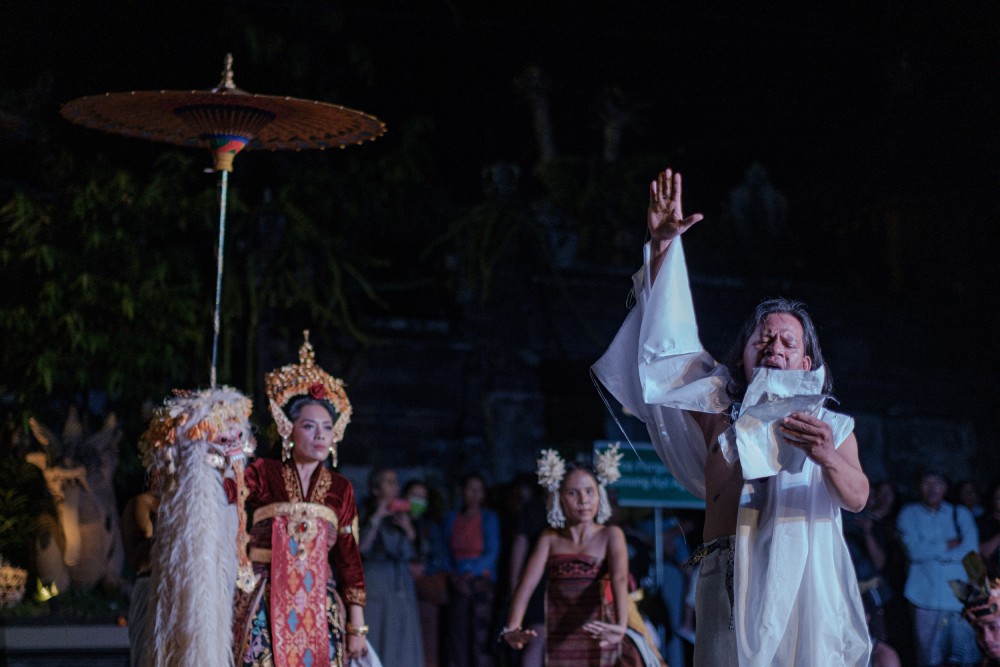
An extraordinary event took place on 6 April 2024 in the village of Budakeling, the core village of the brahmana Buda of Bali: the performance, under the name of MaSutasoma, was a gambuh dance telling the Javanese story of Sutasoma, the most famous of the Javanese Boddhisatwas, which expounds the path toward Buddhist “Release” of the brahmana Budas from generation to generation. Yet, the Sutasoma is also the story from which Indonesia has picked up its motto: Bhinneka Tunggal Ika, Different but One. The show, which was also a “doctorate” exam by Dayu Ani (Ida Ayu Wayan Arya Satyani), explores the encounter of traditional and modern tolerance.
The Presence of Mahayana Buddhism in Bali
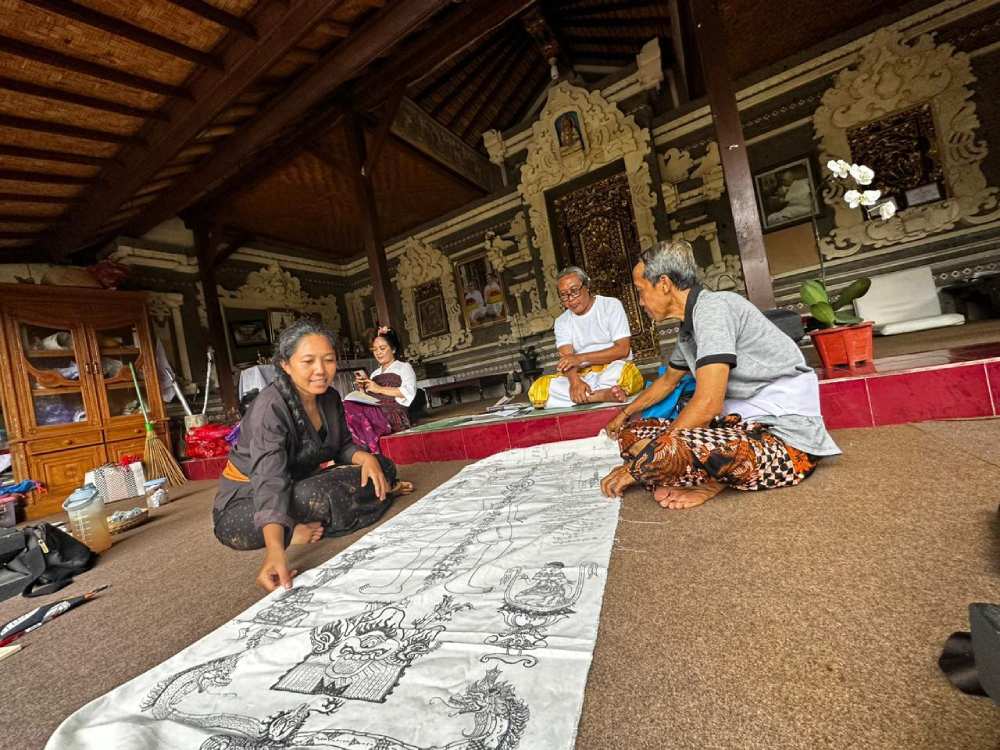
First things first: What are Buddhist Mahayana teachings doing here? Aren’t Balinese Hindu? Yes and no! Balinese religion encompasses ancestral worship and the worship of natural forces, on top of which a Hindu-Buddhist cosmology of Javanese origin is superimposed. At the head of this latest tradition are found the Brahmana clans, whose ancestors came to Bali during the days of King Waturenggong in the 16th century, when the pressure of Islamisation pushed them out of Java.
Best known among these migrants is Dang Hyang Nirartha, who gave birth to the four Brahmana Siwa clans, from which originate most pedanda high priests. But no less important is Dang Hyang Astapaka, from which issued the clan, a single one, of the Boda brahmana and its own pedanda of Buda high priests. In important ceremonies, the two “paths”, that of Siwa and that of Boda, are followed simultaneously, with the participation of the two types of pedandas. This ritual cohabitation is a historical leftover from the religious Siwa-Boda culture of the Majapahit days (13th-16th century). The name “Hindu” is merely a modern term, introduced through contemporary schooling.
Most extraordinary in the dance performed in Budakeling on the 6 April is that the Buddhahood referred to is symbolically alive: the path of the “Buddha” (or Boddhisatwa). Sutasoma is, since the time of Astapaka, followed by all the pedanda Buda of Budakeling: during the death cremation rites, each pedanda Boda is said to be “swallowed” by Batara Kala, the God of Time. This shows clearly in the drawing made on the kajang, the cloth with which the corpse of the ‘dead’ high priest is covered prior to cremation. Swallowed by Time, and burned into nothingness, the priest fully “becomes Sutasoma” (MaSutasoma) or a full Buddha, and heads to the Nirwana without further post-cremation ceremonies, unlike the other types of pedanda priests. Such rites have been going on in Budakeling for centuries.
An Epic MaSutasoma Performance
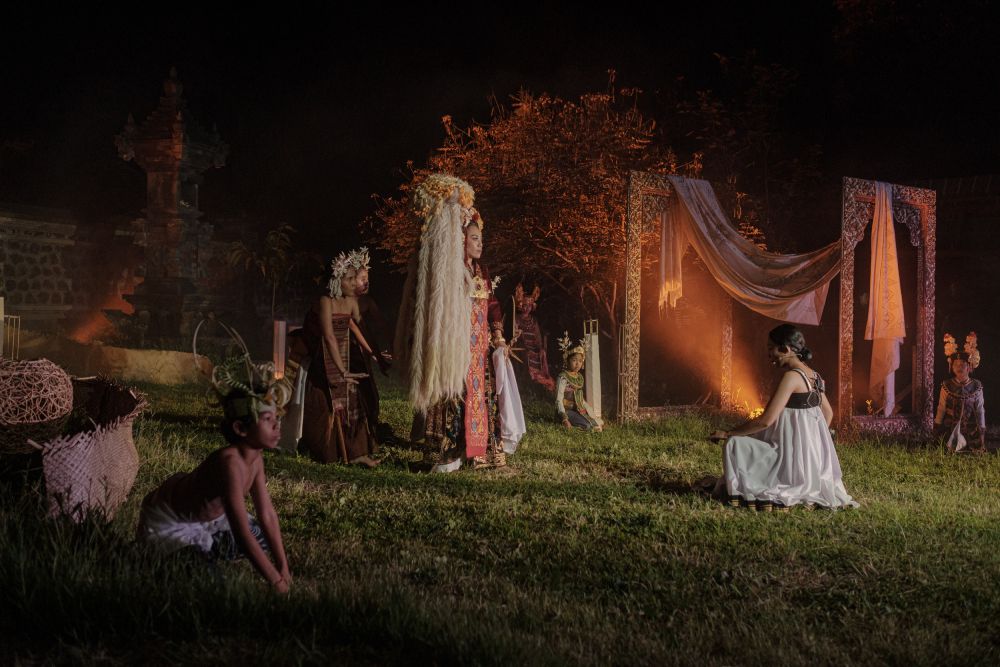
It so happens that the director of the Masutasoma show, Dayu Ani, is a member of the Brahmana Buda clan of Budakeling. By representing “MaSutasoma” she literally performed the process of Buddhahood or “becoming Sutasoma” of her own Brahmana ancestors and fellow citizens. However, it was the first time that anyone ever took up the Sutasoma story in the classical manner of the gambuh. She dared undertaking it though, but only after consulting village elders and priests.
The show was a big success. She took as a stylistic core the gambuh dance such as it still exists today in Budakeling, usually with Panji stories, and unfurled the Sutasoma epic within its framework. She reworked the choreography and restored the old classical gambuh movements with the help of old village masters, while at the same time enriching the dances with a new gestural vocabulary. She also introduced musical innovations, albeit without tinkering with the world-famous gambuh flute-playing. The result was a transformative visual spectacle. Total theatre. All the more so, as we, the spectators, were invited to watch the performance not sitting on one spot, but instead walking along, from one arena to the next, as the story unfolded from one scene to the other toward its finale: The final enlightenment.
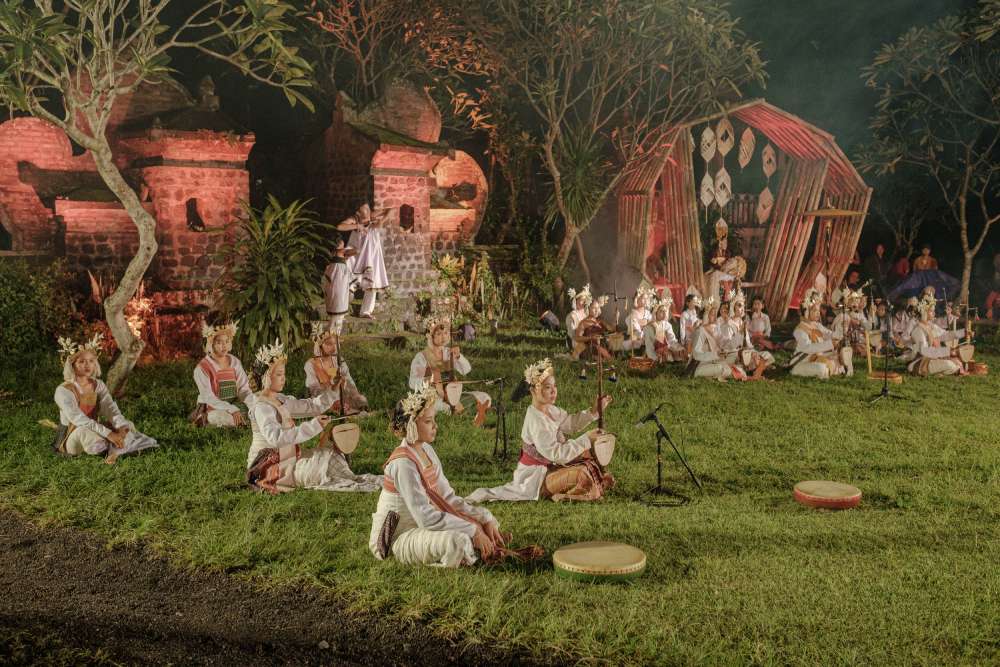
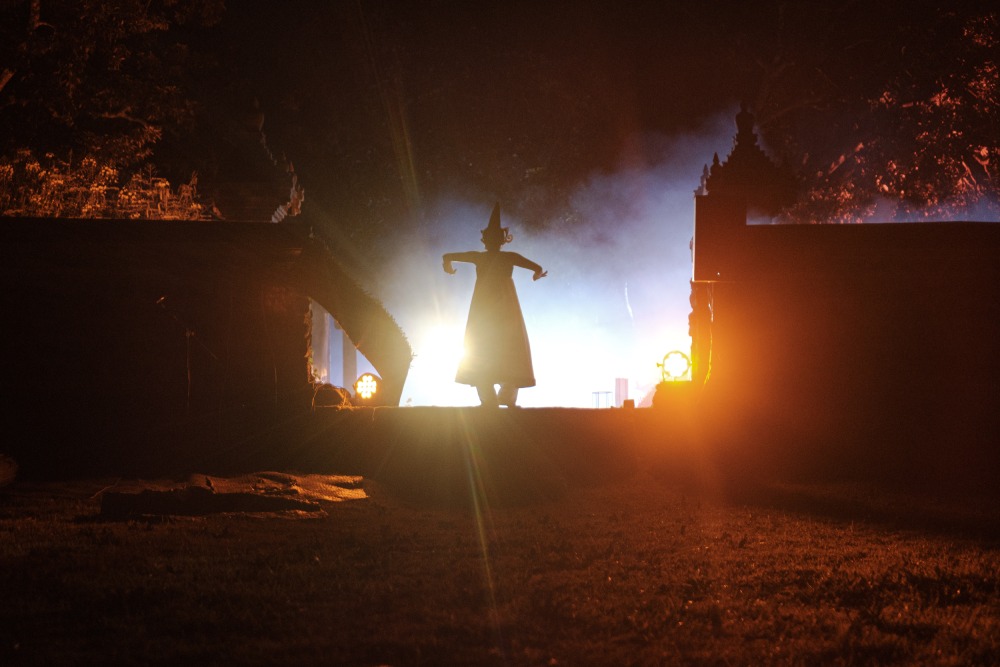
The epic performance included 70 dancers, and 30 musicians and lasted a total of 100 minutes. Show producer, Ida Made Dwipayana of Yayasan Bumi Bajra Sandhi shared that preparations and practice had been undertaken since 2021.
Sutasoma, Reinterpreted
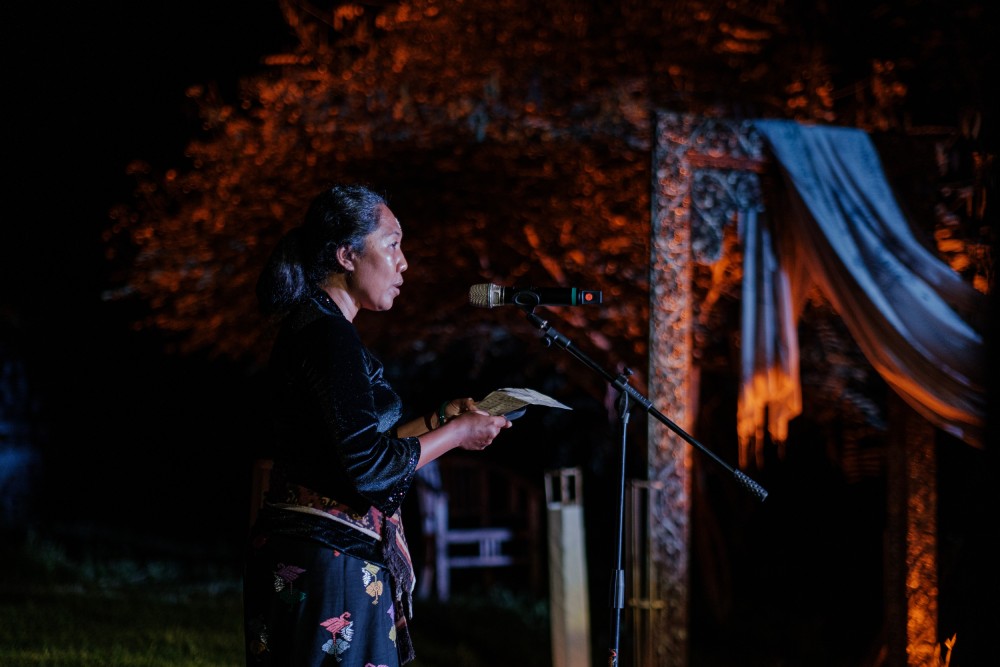
The story of this Sutasoma is already well known, but Dayu Ani’s interpretation adds a political dimension that gives it an altogether new meaning. To better understand it, let us first summarise the epic poem, written in the 14th century by Empu Tantular. We will then see how a sequel gives it a new meaning.
Born as a “Buddha” incarnate within the kingdom of Hastina, Sutasoma leaves the grandeur of his royal environment to wander on a quest for dharma. He reaches first the Gandamayu cemetery, where he “meets” Durga, who comforts him in his endeavour. He is then successively confronted by three monsters, one with an elephant face, Gajahwaktra, another one with a dragon body, Naga Raja, and a female tiger who wants to devour her own cub to satisfy her hunger. To each, Sutasoma offers himself as food. But when they try to attack him, they are subdued by his holiness as a Buddha incarnate and become his disciples. Sutasoma then continues his spiritual journey accompanied by them. He is asked by several priests and the earth-goddess Pertiwi herself to confront the evil king, the man-eater Purosada. Yet he refuses as well as he refuses to take sides in conflicts between local kings: his path is the path of meditation and peace. Meanwhile, the world is engulfed in an orgy of war and violence because King Purosada has captured 100 kings he wishes to offer to Batara Kala to be cleansed of his man-eating habit. But Batara Kala refuses the offering; he is not interested in devouring the 100 kings, he instead wants Sutasoma, the reputation for holiness of whom has reached his ears. Sutasoma refuses to confront Purosada and is easily captured. Taken to Batara Kala he could indeed resist but instead agrees to be devoured if all 100 kings are released. Purosada is moved by this invitation to self-sacrifice and is himself enlightened. It is the epiphany: a sacred advice then announced to the world: “Mangka ng Jinatwa kelawan Siwatatwa tunggal. Bhinneka Tunggal Ika, tan ada dharma mangrwa,” or: The teachings of Buddha and the teachings of Shiva are one. They are different but one, as there is no truth (dharma) that can become two”. The Sutasoma is a Buddhist call for religious tolerance between Buddhism and Shivaism. And indeed Siwa-Buda was venerated as one in the days of Majapahit.
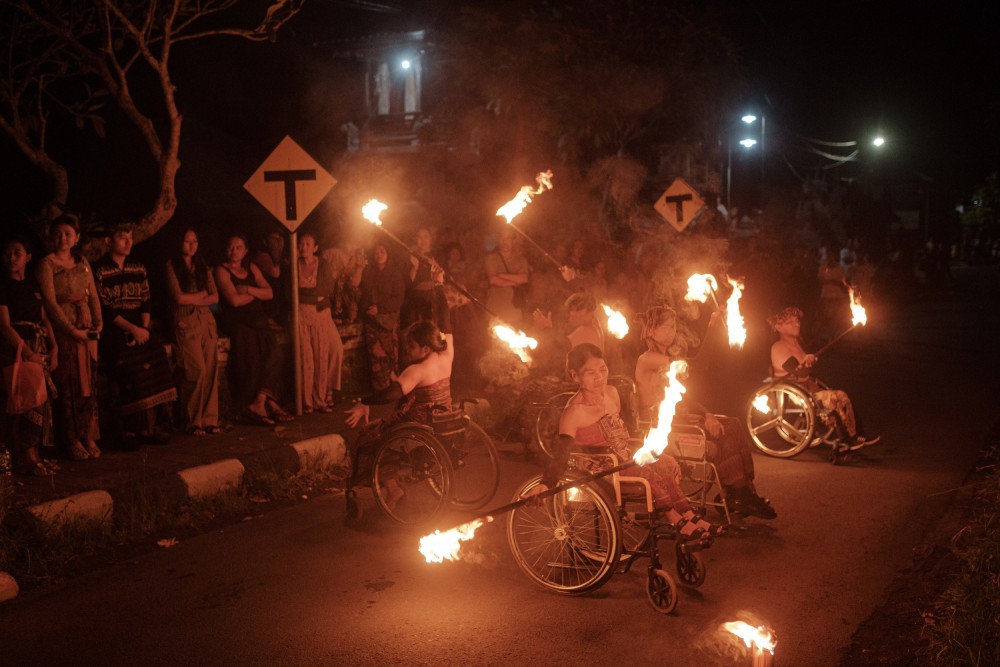
Bhinneka Tunggal Ika has taken a broader meaning in 1945, when it became the motto of the Indonesian Republic, now translated as “Different but One” or “Unity in Diversity”. This meaning appears in the present performance just after the Bhinneka formula is uttered: firstly appeared a “dance” performed by dozens of differently-abled people on wheelchairs, each brandishing whirling torches in the darkness. It meant that “difference” due to disability was to be accepted as part of the oneness of the nation. Then, as the torches were beginning to fade, suddenly were heard the rhythmic beats of the Islamic burdah drum, interspersed with the Islamic Shahada. This was the contribution of the Muslim community of Saren Jawa, neighbours of the Hindu Bali village of Budakeling.
Through the medium of gambuh, and in harmony with Tantular’s verses, another type of religious difference was being celebrated here, as another form of unity. The literary legacy of the Majapahit era thus meets here with the political legacy of the Indonesian state. What was tolerance between Buddhism and Shivaism (Hindu) is now tolerance between Balinese Hinduism and Islam and, beyond, universal tolerance. That is the magic of Dayu Ani’s Gambuh MaSutasoma performance.
Director: Dayu Ani (Ida Ayu Wayan Arya Satyani), already well-known in the field of Balinese dance. Living in Denpasar, she grew up there as a young dancer, the daughter and disciple of the maestro Oka Granoka, a well-known interpreter of the cosmological formulas of Brahmin Buddhist scriptures. A participant in many national and international events.
Producer: Ida Made Dwipayana,
Assistant Director: I.G. Radiana Putra,
Music: I Wayan Diana Putra,
Main Dancers: Ida Ayu Wayan Prihandari, Ni Kadek Thaly Titi Kasih,
Choreographers: Putu Parama Kesawa Ananda Putra, Pande Putu Kevin Dian Muliarta, Ni Komang Sri Wahyuni, Ida Bagus Putu Radhitya Mahasena, Jasmine Okubo.
In memory of Cok Sawitri, who passed away before the final performance.






